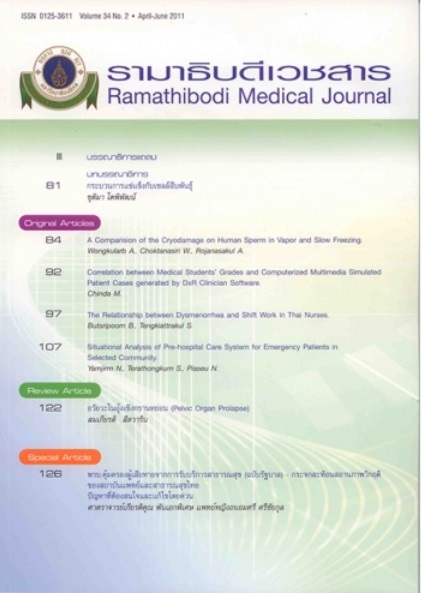The Relationship between Dysmenorrhea and Shift Work in Thai Nurses
Keywords:
Dysmenorrhea, Menstrual symptom, Shift workAbstract
Background: Dysmenorrhea is a common health problem among reproductive women, and may affect female nurse experiencing stress from their occupation. Mostly, nurses were employed on shift work involving night work which may disrupt hormone production due to circadian rhythms changing.
Objective: This study aimed to examine the relationship between dysmenorrhea and shift work in Thai nurses.
Method: The prospective correlational design was used to investigate the occurrence and intensity of dysmenorrhea. One hundred and sixty-one, 20-45 year old. Thai nurses were recruited from four hospitals in Bangkok. Data related to occurrence and intensity of menstruation were obtained, for two consecutive menstrual cycles by the use of the Women’s Daily Health Diary (DHD). Binary logistic regression was used to identify shift work and dysmenorrhea.
Results: The prevalence of dysmenorrhea in Thai nurse was 36.5%. The most common associated symptoms were abdominal pain or discomfort (78%), backache (76.3%), fatigue (66.1%), general aches (59.3%), irritability (59.3%), rapid mood change (55.9%), headache (50.8%), increased appetite (45.8%), increased food intake (45.8%), craving for specific food (44.1%), diarrhea (42.4%), decreased appetite (33.9%), and impatient (32.2%). About sixty four percent of nurses had work schedule both day and night shift and 36.3% worked only day shift. There is no statistically significant relationship between dysmenorrhea and shift work in Thai nurses.
Conclusion: Not only dysmenorrhea, but also other associated symptoms could affect on women for each month. Although the association between dysmenorrhea and shift work in nurses was not found, the nurse who affected from dysmenorrhea should be concerned.
References
Sueblinvong T. Pelvic Inflammatory Disease (PID). In: Weerakiet S, Wilailak S, eds. Gynecology. Bangkok: Holistic Publishing; 2005:125-50.
Harel Z. Dysmenorrhea in adolescents and young adults: etiology and management. J Pediatr Adolesc Gynecol. 2006;19(6):363-71. doi:10.1016/j.jpag.2006.09.001.
Spears LG. A narrative review of medical, chiropractic, and alternative health practices in the treatment of primary dysmenorrhea. J Chiropr Med. 2005;4(2):76-88. doi:10.1016/S0899-3467(07)60117-7.
Houston AM, Abraham A, Huang Z, D'Angelo LJ. Knowledge, attitudes, and consequences of menstrual health in urban adolescent females. J Pediatr Adolesc Gynecol. 2006;19(4):271-5. doi:10.1016/j.jpag.2006.05.002.
Wong LP, Khoo EM. Dysmenorrhea in a multiethnic population of adolescent Asian girls. Int J Gynaecol Obstet. 2010;108(2):139-42. doi:10.1016/j.ijgo.2009.09.018.
Banikarim C, Chacko MR, Kelder SH. Prevalence and impact of dysmenorrhea on Hispanic female adolescents. Arch Pediatr Adolesc Med. 2000;154(12):1226-9. doi:10.1001/archpedi.154.12.1226.
Hillen TI, Grbavac SL, Johnston PJ, Straton JA, Keogh JM. Primary dysmenorrhea in young Western Australian women: prevalence, impact, and knowledge of treatment. J Adolesc Health. 1999;25(1):40-5. doi:10.1016/s1054-139x(98)00147-5.
Ohde S, Tokuda Y, Takahashi O, Yanai H, Hinohara S, Fukui T. Dysmenorrhea among Japanese women. Int J Gynaecol Obstet. 2008;100(1):13-7. doi:10.1016/j.ijgo.2007.06.039.
Pitts MK, Ferris JA, Smith AM, Shelley JM, Richters J. Prevalence and correlates of three types of pelvic pain in a nationally representative sample of Australian women. Med J Aust. 2008;189(3):138-43.
Patel V, Tanksale V, Sahasrabhojanee M, Gupte S, Nevrekar P. The burden and determinants of dysmenorrhoea: a population-based survey of 2262 women in Goa, India. BJOG. 2006;113(4):453-63. doi:10.1111/j.1471-0528.2006.00874.x.
Chan SS, Yiu KW, Yuen PM, Sahota DS, Chung TK. Menstrual problems and health-seeking behaviour in Hong Kong Chinese girls. Hong Kong Med J. 2009;15(1):18-23.
Ortiz MI, Rangel-Flores E, Carrillo-Alarcón LC, Veras-Godoy HA. Prevalence and impact of primary dysmenorrhea among Mexican high school students. Int J Gynaecol Obstet. 2009;107(3):240-3. doi:10.1016/j.ijgo.2009.07.031.
Singh A, Kiran D, Singh H, Nel B, Singh P, Tiwari P. Prevalence and severity of dysmenorrhea: a problem related to menstruation, among first and second year female medical students. Indian J Physiol Pharmacol. 2008;52(4):389-97.
Ozerdogan N, Sayiner D, Ayranci U, Unsal A, Giray S. Prevalence and predictors of dysmenorrhea among students at a university in Turkey. Int J Gynaecol Obstet. 2009;107(1):39-43. doi:10.1016/j.ijgo.2009.05.010.
Agarwal A, Venkat A. Questionnaire study on menstrual disorders in adolescent girls in Singapore. J Pediatr Adolesc Gynecol. 2009;22(6):365-71. doi:10.1016/j.jpag.2009.02.005.
Tangchai K, Titapant V, Boriboonhirunsarn D. Dysmenorrhea in Thai adolescents: prevalence, impact and knowledge of treatment. J Med Assoc Thai. 2004;87 Suppl 3:S69-73.
Sharifian A, Farahani S, Pasalar P, Gharavi M, Aminian O. Shift work as an oxidative stressor. J Circadian Rhythms. 2005;3:15. doi:10.1186/1740-3391-3-15.
Chung FF, Yao CC, Wan GH. The associations between menstrual function and life style/working conditions among nurses in Taiwan. J Occup Health. 2005;47(2):149-56. doi:10.1539/joh.47.149.
Lee LK, Chen PC, Lee KK, Kaur J. Menstruation among adolescent girls in Malaysia: a cross-sectional school survey. Singapore Med J. 2006;47(10):869-74.
Totterdell P, Spelten E, Pokorski J. The effects of nightwork on psychological changes during the menstrual cycle. J Adv Nurs. 1995;21(5):996-1005. doi:10.1046/j.1365-2648.1995.21050996.x.
Mitchell ES, Woods NF, Lentz MJ. Recognizing PMS When You See It: Criteria for PMS Sample Selection. In: Taylor DL, Woods NF, eds. Menstruation, Health and Illness. Washington DC: Hemisphere; 1991:89-102.
Butsripoom B, Hanucharurnkul S, Arpanantikul M, Choktanasiri W, Vorapongsathorn T, Sinsuksai N. Premenstrual syndrome among Thai nurses: prevalence, impact and self-management strategies. Thai J Nurs Res. 2009;13(4):285-301. Available from: https://www.tci-thaijo.org/index.php/PRIJNR/article/view/6473.
Jamieson DJ, Steege JF. The prevalence of dysmenorrhea, dyspareunia, pelvic pain, and irritable bowel syndrome in primary care practices. Obstet Gynecol. 1996;87(1):55-8. doi:10.1016/0029-7844(95)00360-6.
Rapkin AJ, Chang LC, Reading AE. Comparison of retrospective and prospective assessment of premenstrual symptoms. Psychol Rep. 1988;62(1):55-60. doi:10.2466/pr0.1988.62.1.55.
Chongpensuklert Y, Kaewrudee S, Soontrapa S, Sakondhavut C. Dysmenorrhea in Thai secondary school students in Khon Kaen, Thailand. Thai J Obstet Gynaecol. 2008;16:47-53. Available from: https://www.tci-thaijo.org/index.php/tjog/article/view/82306/pdf_81.
Yamamoto K, Okazaki A, Sakamoto Y, Funatsu M. The relationship between premenstrual symptoms, menstrual pain, irregular menstrual cycles, and psychosocial stress among Japanese college students. J Physiol Anthropol. 2009;28(3):129-36.
Harlow SD, Park M. A longitudinal study of risk factors for the occurrence, duration and severity of menstrual cramps in a cohort of college women. Br J Obstet Gynaecol. 1996;103(11):1134-42. doi:10.1111/j.1471-0528.1996.tb09597.x.
Harel Z. Dysmenorrhea in adolescents. Ann N Y Acad Sci. 2008;1135:185-95. doi:10.1196/annals.1429.007.
Labyak S, Lava S, Turek F, Zee P. Effects of shiftwork on sleep and menstrual function in nurses. Health Care Women Int. 2002;23(6-7):703-14. doi:10.1080/07399330290107449.













